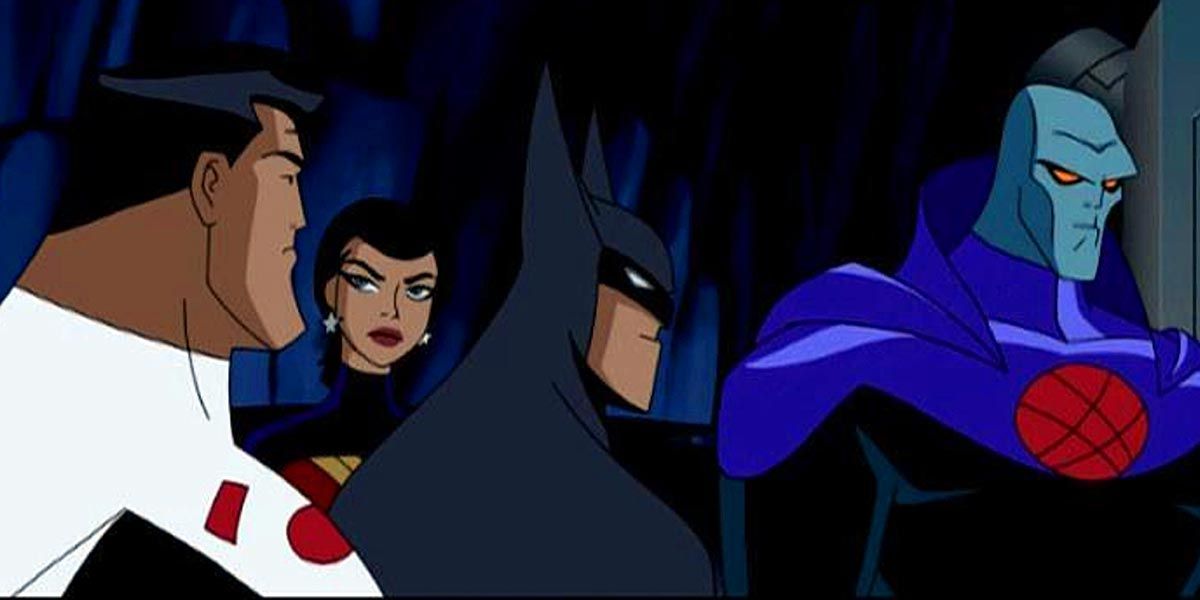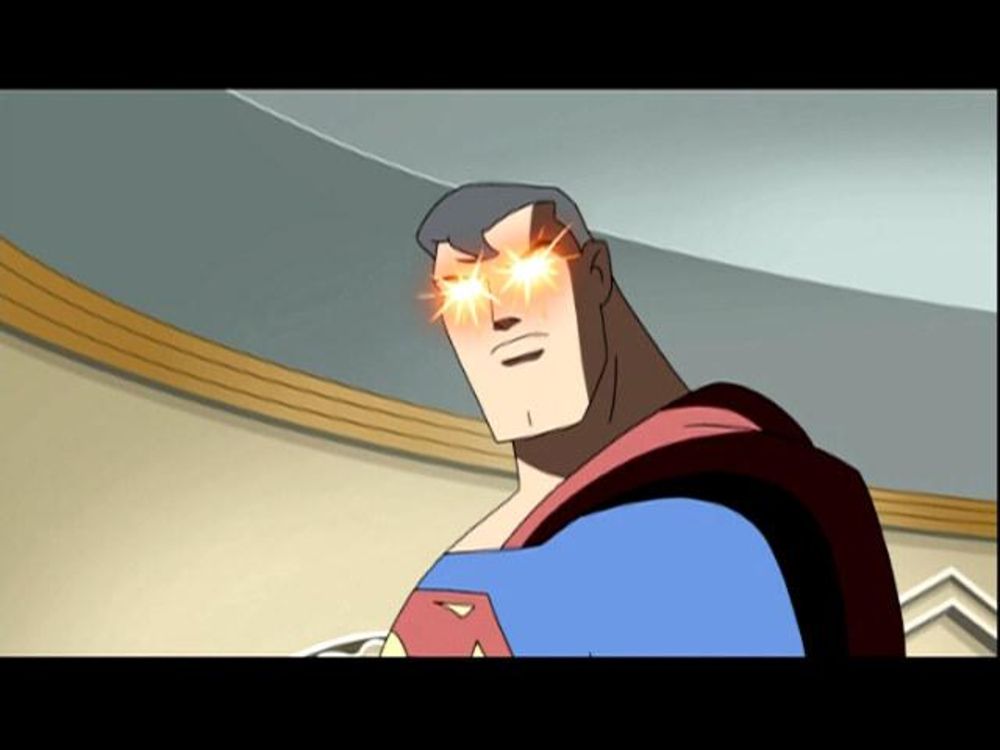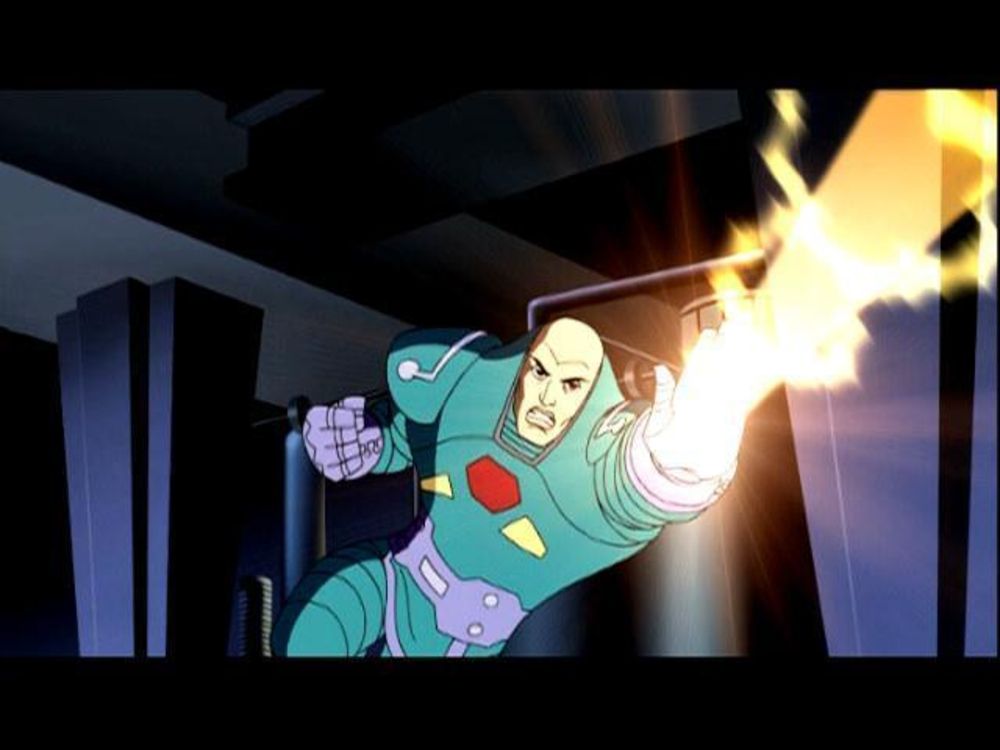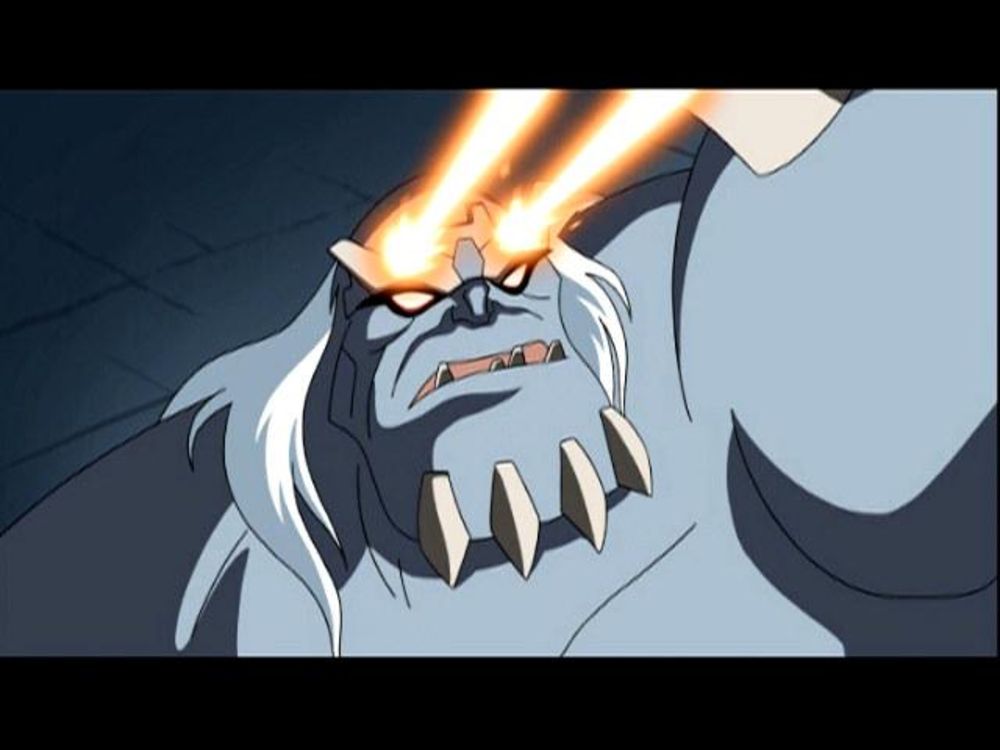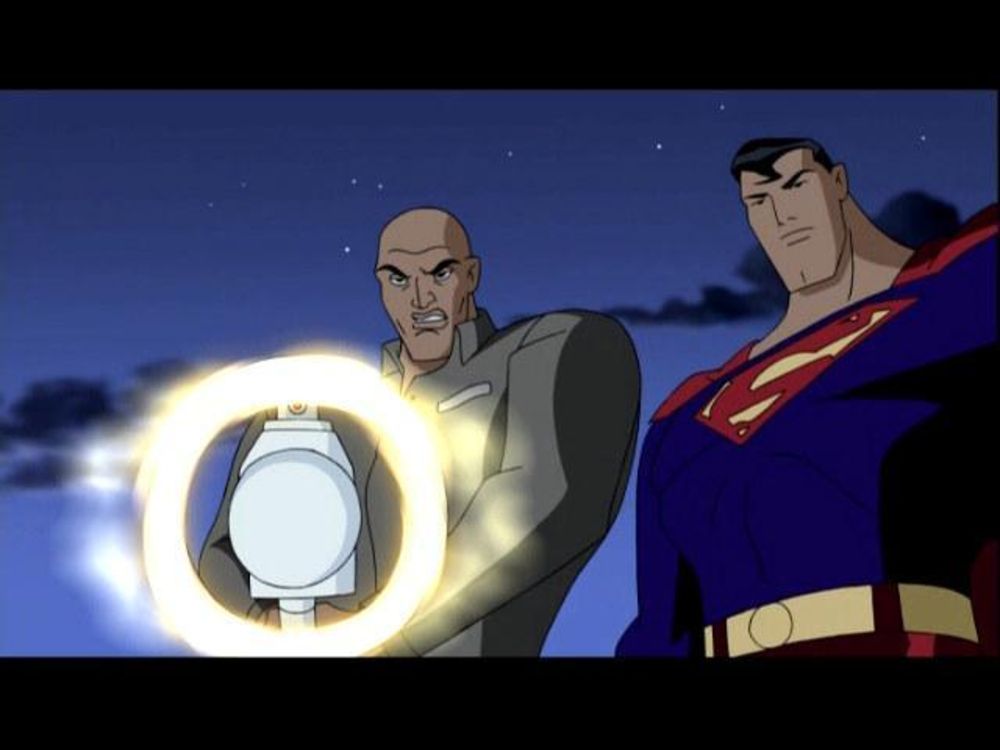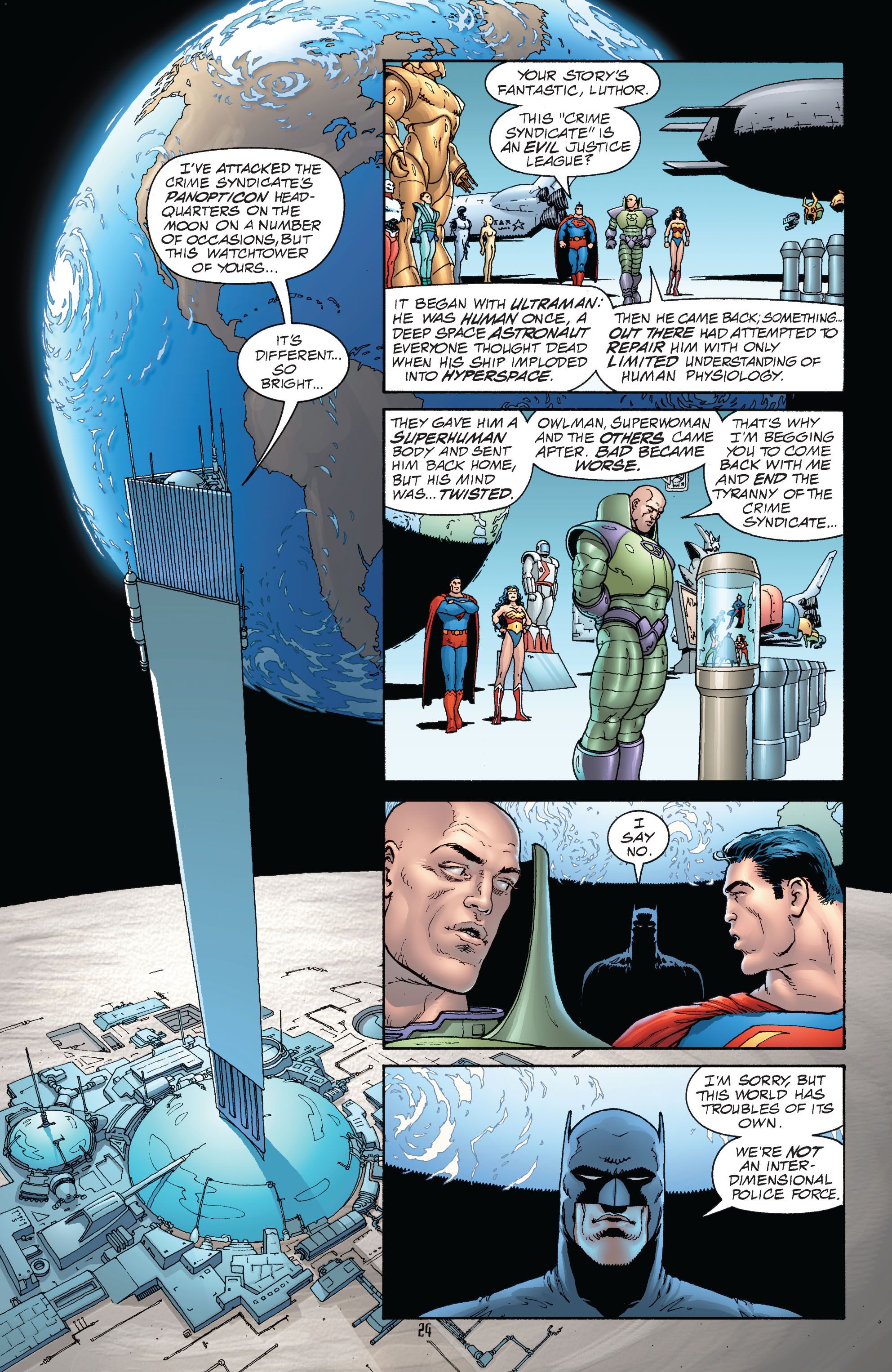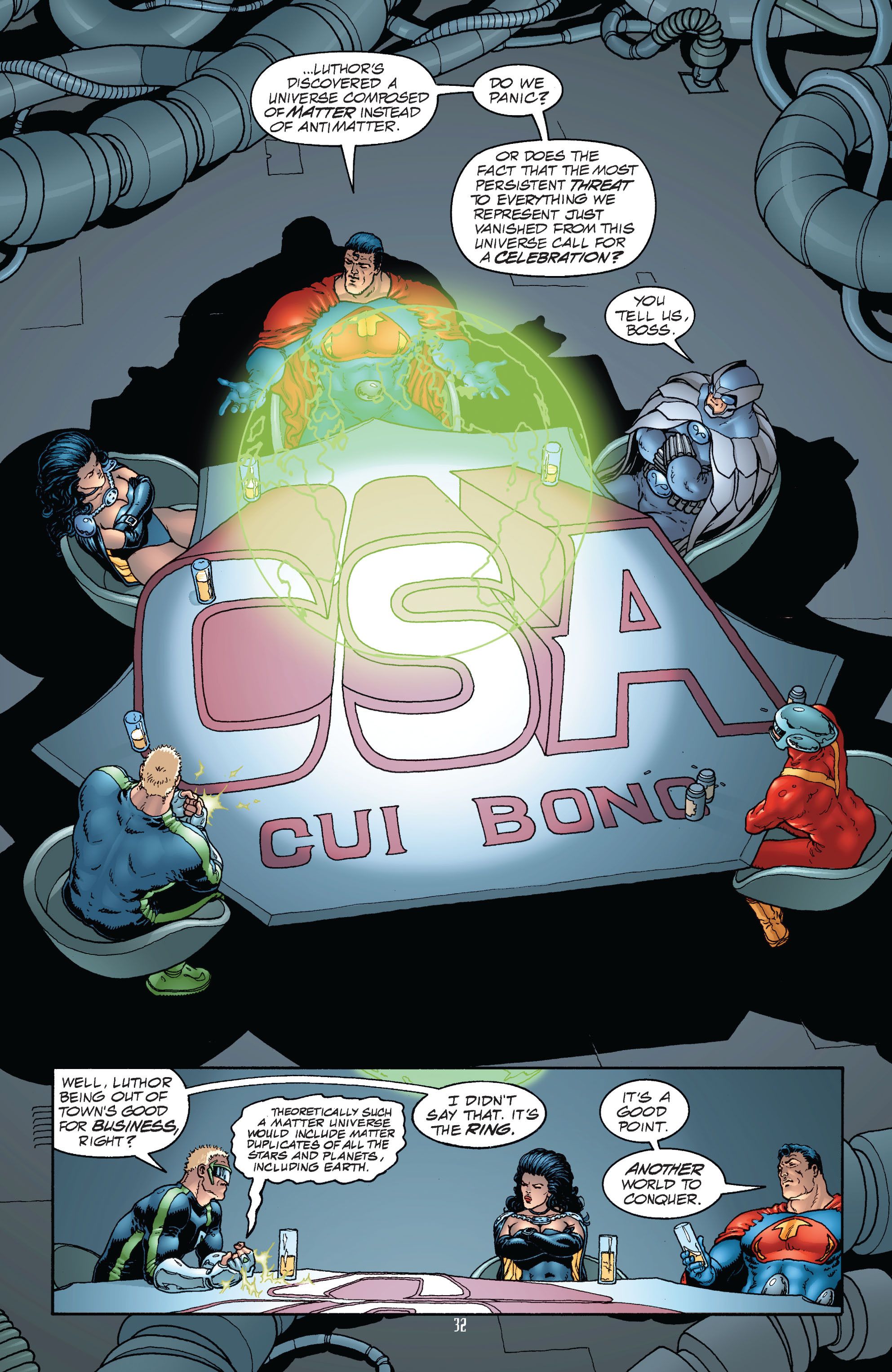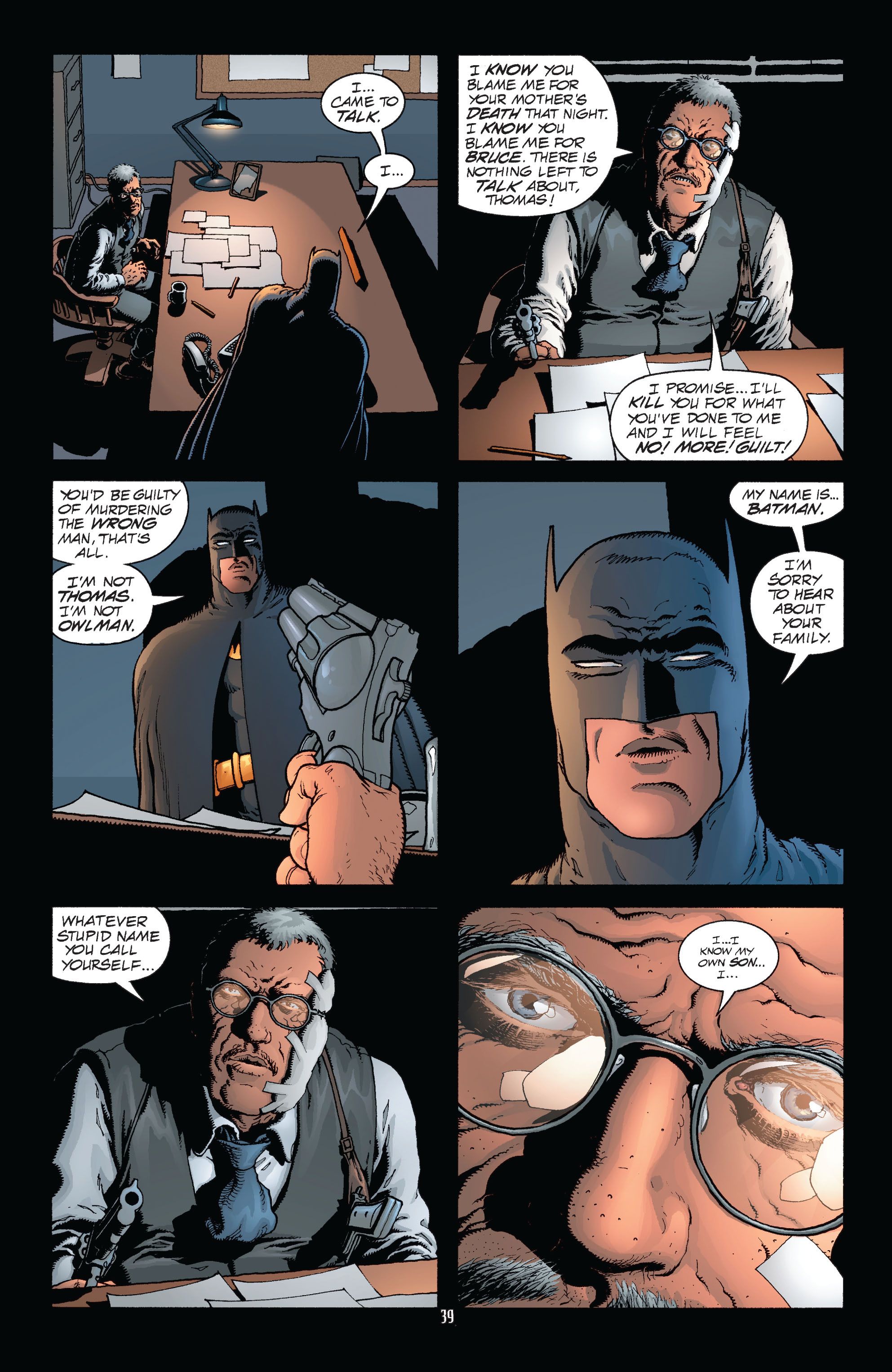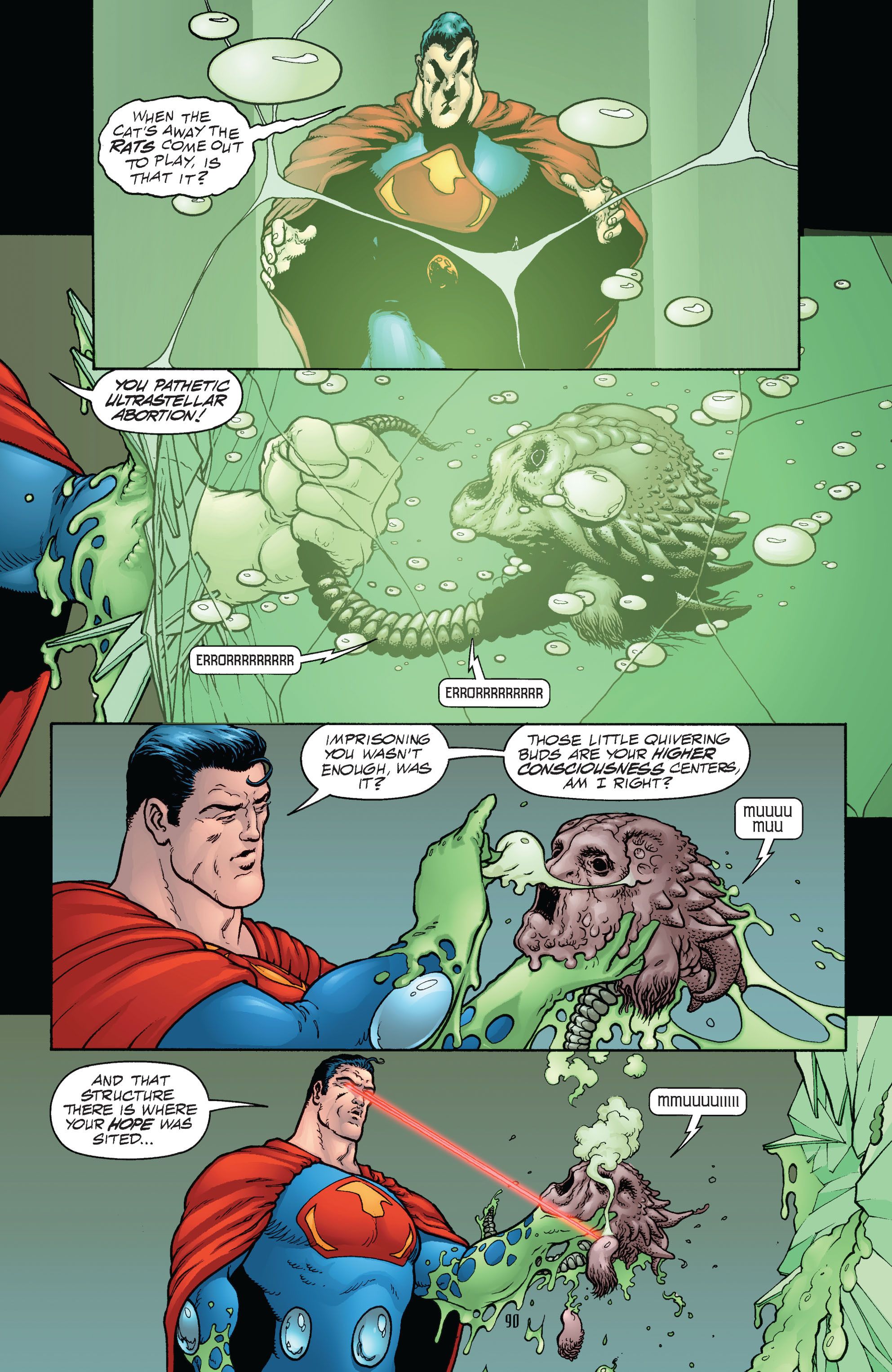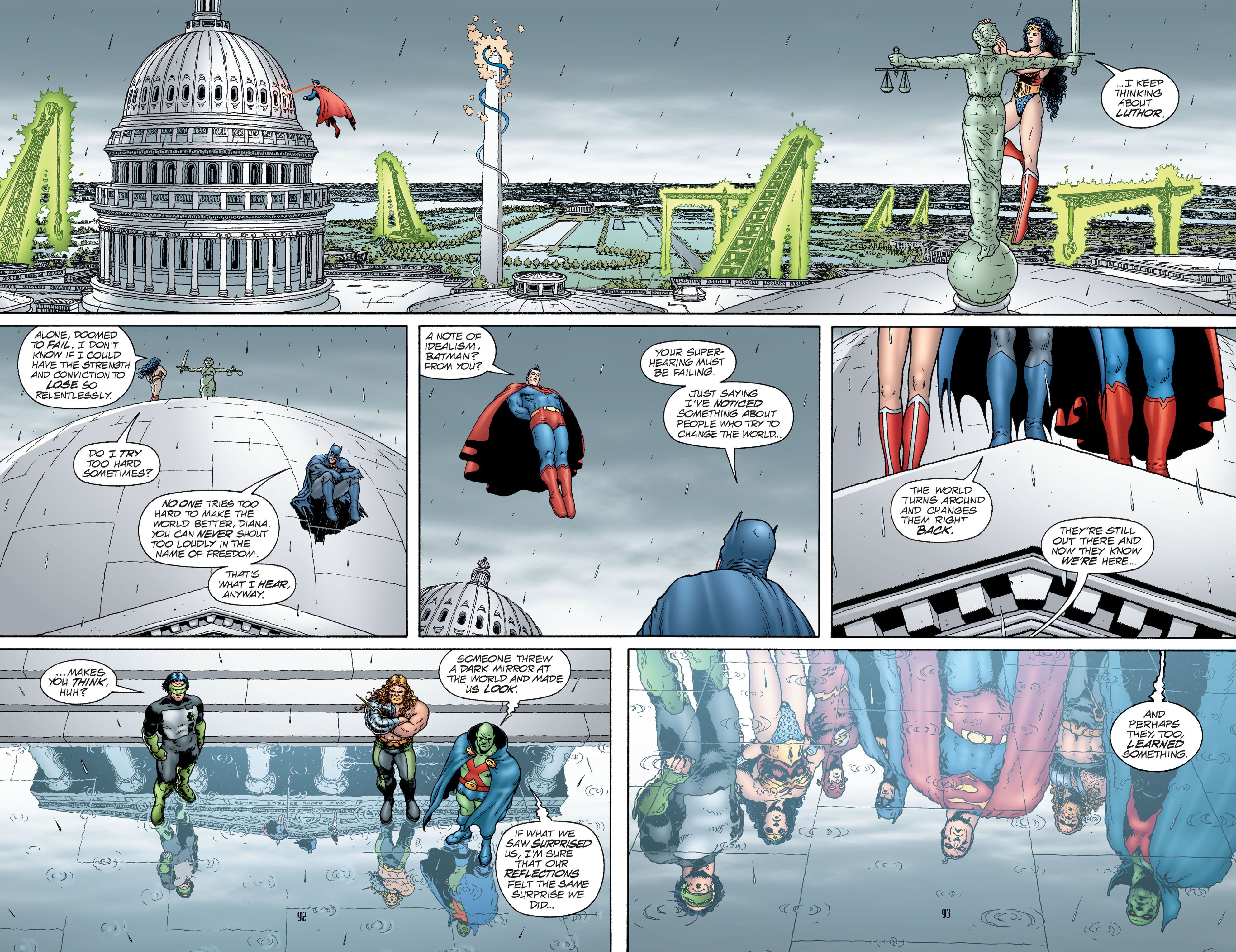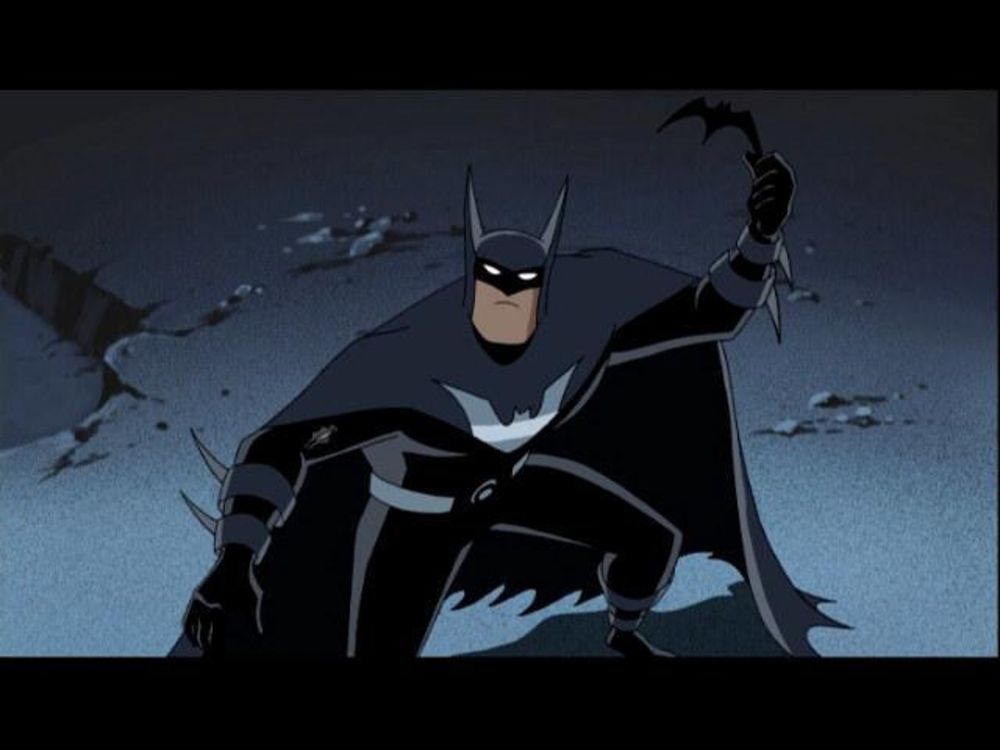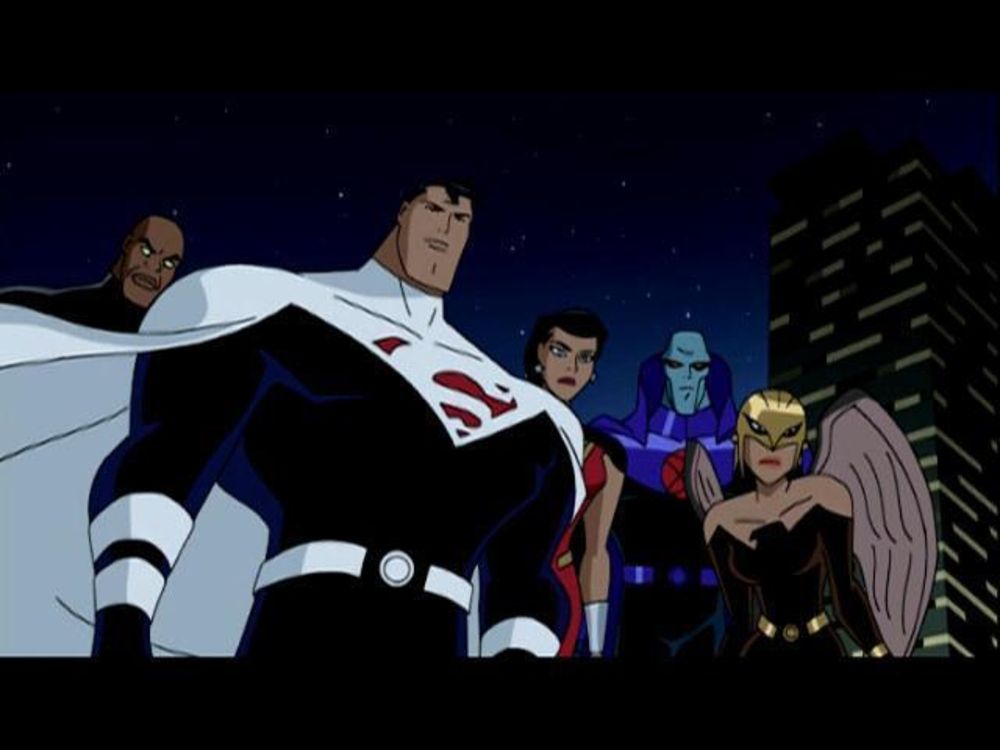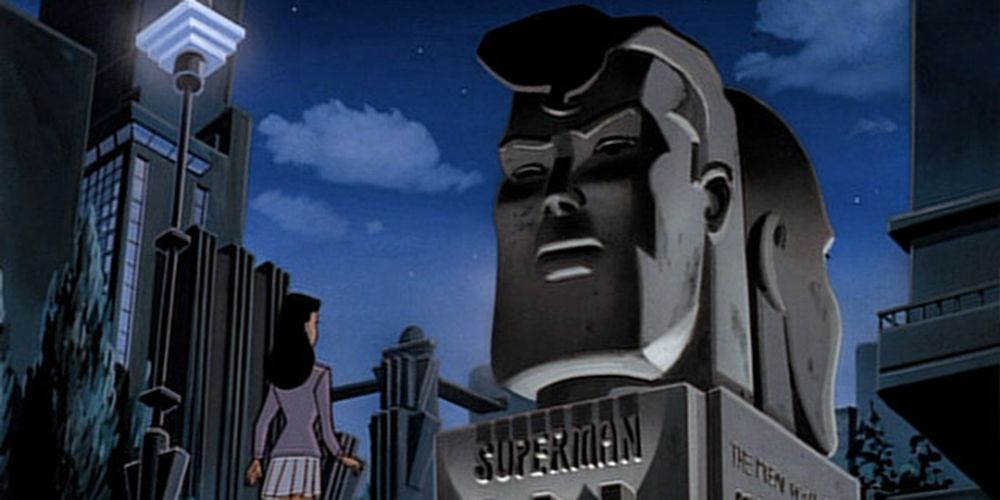Welcome to Adventure(s) Time's 98th installment, a look at animated heroes of the past. This week, a pivotal moment in the DC Animated Universe, along with its original comics inspiration. And if you have any suggestions for the future, I'd love to hear them. Just contact me on Twitter.
Nov. 1, 2003 brought us the strangest cold opening ever for a Justice League episode: The League is storming the White House. Lex Luthor, now mad, is president. And Superman's response to Luthor's threat to push the big red button ... well, let's say it involves his heat vision and causes a certain smell to permeate the residence.
What is this? The audience is let off the hook, somewhat, after the opening credits. "A Better World," from writer Stan Berkowitz and director Dan Riba, is the introduction of the Justice Lords. Two years after the cold open, they rule over an alternate world; one cleaner and safer than ours, but far less free.
The Lords have been so successful in enforcing peace, they find themselves bored. Their Batman, desperate for some kind of entertainment, has even used his intellect to explore the concept of alternate worlds. And he's discovered ours.
The team observes the Justice League (the Lords Batman implies this was never their name) battle Lex Luthor, here a clear supervillain, in public. Their J'onn J'onzz appears, warning the League of a dire threat on his home world. The team follows and is immediately zapped into unconsciousness.
The goal of the Lords, as it turns out, is to impose their rule on this reality. Conveniently, within a few minutes of their arrival, a new threat crashes in from space. A threat DCAU co-creator Bruce Timm once vowed to never introduce into this canon. Doomsday.
The Lords defend Metropolis from the threat; a battle that ends with Superman using his heat vision to literally lobotomize Doomsday. (Who is no mindless beast here; just someone looking for a challenge to prove himself.) Lois Lane is there, disgusted by Superman's actions. The rest of the crowd, however, loves it.
Elsewhere, the League finds itself prisoner in the Lords' reality. Additional exposition reveals the Lords took a harsher stance on crime following the death of their Flash. This is played for some humor; understandable due to Flash's irreverent personality, but disappointing if you're looking for more worldbuilding. The idea of any incarnation of the League turning into this is handwaved away with a few lines of dialogue. As far as Batman's concerned, the Lords' actions aren't so different from theirs.
Flash's quick thinking enables the League to escape Lords' custody. Most of the team travels to Arkham Asylum (now a clean, modern facility instead of a haunted mansion) to rescue Hawkgirl, who was injured in the ambush. Batman, however, travels to the Batcave to retrieve the Lords' dimensional teleporter. There, he encounters the Lords Batman, and ultimately, turns him to Batman's cause. No impassioned speeches, just the cold observation that the parents Batman so desperately wants to avenge would be ashamed of him for helping to create this world.
After returning to our reality, Superman approaches Luthor for help against the Lords . The League distracts the Lords long enough for Luthor to use his newly-crafted power disruptor to strip them of their abilities. The Lords are apprehended, as Luthor reveals he's aided the League in exchange for a presidential pardon.
In one of the most memorable endings for the series, Luthor expresses his goal of entering politics. Did the League just create the world they've been fighting against? "A Better World" changes everything for the show, introducing a nuanced take on good and evil and a more complex mythology.
According to the producers, this two-parter began as a possible adaptation of JLA: Earth 2, a 1999 graphic novel from Grant Morrison and Frank Quitely. Earth 2 served as the modern-day introduction of the Crime Syndicate of America, a version of the League from an inverted world where good is evil. Ultimately, they decided a story about a rogue, but not truly evil, Justice League had more story potential. The inspiration is clear, however, when you go back to Earth 2.
The graphic novel opens with Alexander Luthor, the "good" Luthor from the Antimatter universe, arriving in what he calls Earth-2, seeking the JLA's help. Meanwhile, the Crime Syndicate have learned of Luthor's plan, and decided to rule this positive-matter universe as well. The result is the JLA attempting to do good in the Antimatter universe, while the Crime Syndicate launches an attack on our earth.
Echoing the cartoon (or the other way around), the Crime Syndicate target the White House. There's also a bit about Batman only reluctantly going along with this mission, then ending up in a twisted version of Gotham that evokes memories of his parents.
In this story, the members without CSA counterparts stay behind, meaning Aquaman and Martian Manhunter are able to defeat the villains in Washington. This turns out to be the crux of the story. The JLA can't do any lasting good on the Antimatter world because evil and corruption are the natural order. Meanwhile, justice prevails on this world, so two JLA members left as backup end up defeating the CSA.
An additional twist has Ultraman's servant, the antimatter Brainiac, secretly manipulating Luthor the entire time. (Ultraman is the evil Superman, of course. A human astronaut given super powers by an alien race following an accident.) Luthor's actions will unintentionally result in the two Earths merging into the same space and destroying each other.
Superman, unwilling to kill Brainiac, realizes he can't win on this earth. Soon, the teams swap places to their home worlds. Ultraman, naturally, has no such compulsions against killing.
He gives Brainiac a heat-vision lobotomy, ending the threat. (Another bit that inspired a pivotal moment in the cartoon, only with Doomsday as the victim.)
At the story's end, we check in on both teams in their respective White Houses. The context is different in the cartoon, but in both cases, the optimistic tone is tinged with a hint of darkness.
The story's filled with typical Morrison bits, such as the airplane that's crossed the barrier, killing every passenger. The JLA discover the victims have hearts on the wrong side of their body, currency in their wallets bearing the slogan "In Mammon We Trust" and the face of Benedict Arnold. Along the way, we have numerous cool-sounding but also borderline-nonsense rationalizations for how all of this can be happening. If you want a primer on Morrison taking Silver Age goofiness and modernizing it into something a Williamsburg hipster can embrace, this is it.
DESIGN-Y
The Justice Lord designs are some of the strongest costumes developed by this crew. Batman especially looks sleek and cool. Bruce Timm has commented that he'd considered once giving the actual League a similar matching motif, such as the Lords' identical chest designs.
CONTINUITY NOTES
This two-parter is the crux of Justice League Unlimited's signature story arc. It's also been referenced numerous times in DC's comics continuations of this canon.
A later retcon involving Doomsday doesn't work. We're told in Unlimited he's a clone of Superman, created by the shadowy conspiracy Cadmus after the Lords came to this reality. Here, we clearly see him falling from the sky in some kind of meteorite. Additionally, he can't be Superman's clone if he's created after Cadmus formed...which was after the Justice Lords appeared. Although, he does speak perfect English with an American accent, which would be an argument he's a clone instead of an alien.
APPROVED BY BROADCAST STANDARDS & PRACTICES
A line of dialogue makes it quite clear Justice Lords Green Lantern and Hawkgirl are sleeping together. This is also likely the first forced lobotomy on the Cartoon Network.
NO CRIME, NO VICTIMS, NO PAIN
Would the CSA have worked better than the Justice Lords? Going for "not evil, misguided" versions of the heroes does provide more dramatic fodder. But does the episode do enough to justify recasting the show's heroes as villains? I think it's legitimate to argue Flash's death alone would not make the League go fascist. They're heroes, they risk their lives, they recognize that danger every time they go on a mission. Also, Batman's statement that what they do isn't so different from the Lords...it sounds cool, but doesn't hold up to scrutiny.
It's telling that this team (as it's implied) always called itself the Justice Lords. So, the audience is free to assume these characters were never quite as altruistic as our heroes. Also, the script is smart enough to dance around these thorny issues and just move on to the next scene. It's a story that raises far more questions than answers, but ultimately, it still works. We have the novelty of the "bad" heroes, cool new designs, dimension hopping, and a clever finale.
Another DCAU story from Stan Berkowitz, Superman's "Brave New Metropolis" explores similar themes. This episode also has Superman turning authoritarian, this time motivated by grief following Lois Lane's death. It's a more believable setup than Flash dying (sorry, Wally) and appeared to be an influence on the Injustice video game series. Interestingly, Injustice was serving as inspiration for Zack Snyder's vision for the DC live-action films...for all of one movie before the studio stepped in. This is no original observation, but seriously -- why not have the DCAU creators write these movies? It certainly seems as if Warners could've avoided several headaches, selecting writers who've proven they can handle this material.
So that’s all for now. Until next time, check out the G. I. Joe novels I wrote for the Kindle Worlds project for free over at Smashwords.

